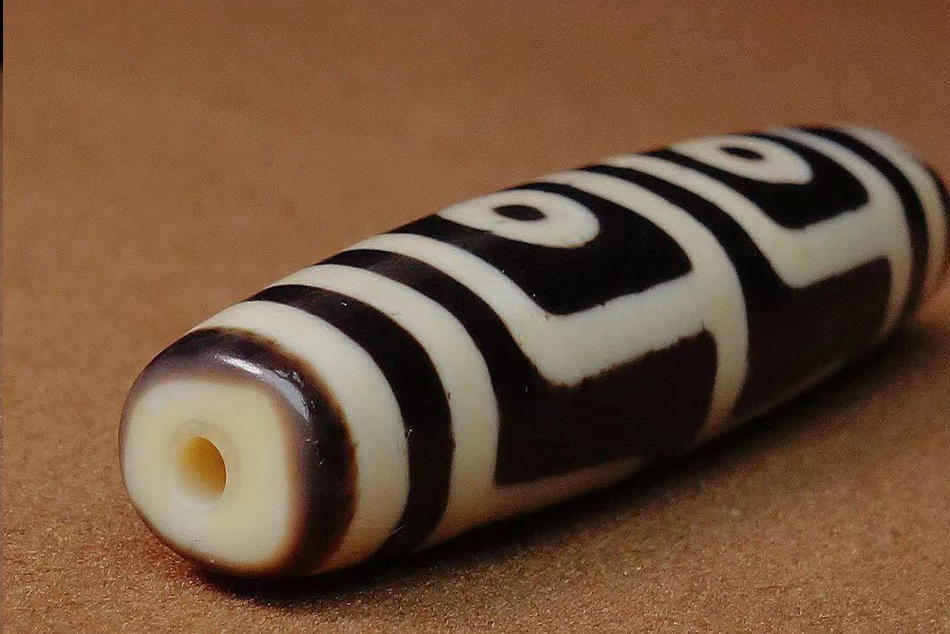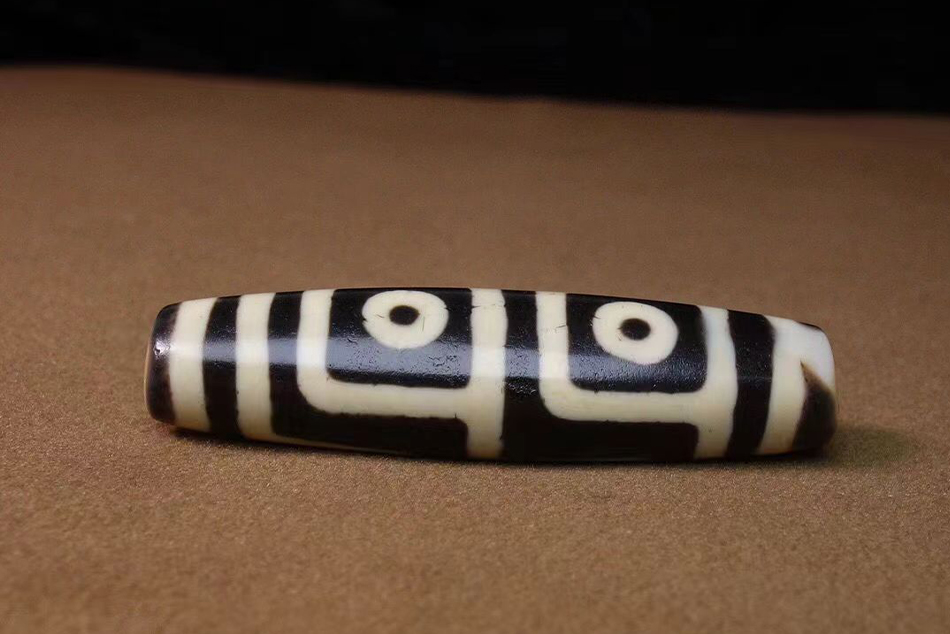Tibetan Dzi beads have captivated the world with their enigmatic charm, weaving a mesmerizing tapestry of history, spirituality, and cultural significance. These small, agate-based artifacts, adorned with intricate patterns and eye-like motifs, hold a unique place in the realm of spiritual and cultural symbolism. They are not merely ornamental trinkets but gateways to a world where myths and realities entwine seamlessly, and where past and present converge to tell a story of immense depth and mystery.
In this comprehensive article, we embark on a journey into the heart of Tibetan Dzi beads, peeling back the layers of their enigma one by one. We will unravel the secrets of their origins, tracing their footsteps from the dawn of ancient civilizations to the high Himalayas. We will explore the profound symbolism etched into these beads, delving into the mystique of the ‘eyes’ that adorn them and the deep spiritual significance they carry. We will shine a light on the crafting methods, revealing the artistry that makes each Dzi bead a work of both nature and human touch. And, we will immerse ourselves in the cultural significance of these beads, understanding their role in Tibetan life and their enduring legacy that extends far beyond the Tibetan plateau.
As we journey deeper into the world of Tibetan Dzi beads, prepare to be captivated by a world where each bead is not just a piece of jewelry but a key to unlock the door to a realm where ancient beliefs and contemporary intrigue blend harmoniously. Let us explore the enigmatic world of Tibetan Dzi beads together, where the past whispers to the present, and the spiritual and cultural mysteries unfurl like an ancient scroll waiting to be read.
The Enigmatic World of Tibetan Dzi Beads
Origins and History
In the heart of the Himalayas, Tibetan Dzi beads carry with them a lineage that stretches back through the annals of history. These enigmatic artifacts boast a rich history, rooted in antiquity, and shrouded in intrigue. To truly appreciate the significance of Dzi beads, we must embark on a journey that transcends time and geography, beginning with their origins.
The genesis of Tibetan Dzi beads can be traced to ancient times, where the Indus River civilization acted as the cradle for these mysterious gems. As we delve into their history, we uncover the remarkable journey these beads have undertaken, traveling from distant lands to their current home in the high Himalayas. Their path winds through the tapestry of human civilization, hinting at tales of trade, cultural exchange, and spiritual significance.
Throughout their history, these beads have exchanged hands and cultures, each interaction imprinting upon them a unique narrative. From the ancient bazaars of the Indus to the remote monasteries of Tibet, Dzi beads have been both treasures and talismans, holding secrets that only the curious and the passionate can hope to unveil.
Categories of Dzi Beads
Within the realm of Dzi beads, diversity reigns supreme. These sacred relics take on a multitude of forms, each carrying a distinct aura and purpose. As we embark on our exploration, we will navigate through this diverse landscape of categories, uncovering the stories and symbolism behind each type.
Dzi beads with eyes, often considered the most sought after, draw our attention first. These eye-like patterns, meticulously etched into the agate canvas, hold a special significance, believed to watch over and protect their wearers. But Dzi beads are not confined to this singular style; they display remarkable diversity.
From the elegant lotus designs to intricate longevity vases, these beads come alive with patterns and symbols that transcend mere ornamentation. Some bear the mark of unique motifs, elevating their desirability. We shall delve into the world of these decorated Dzi beads, unravelling their intricate stories.
As we traverse the categories, we discover Tiger Dzi beads, with their oval shape and double stripe decorations, and the single stripe Tasso Dzi, each with a unique allure. Not to be overlooked are the tabular Luk Mik Dzi beads, which may have originated from India and Western Asia, bearing decorations that hold hidden tales. These beads hold a place of their own within the vast spectrum of Dzi bead categories.
Indeed, the world of Dzi beads is a rich tapestry, woven from countless threads of history, culture, and spirituality. It is a realm where every bead tells a story, and where the categories reveal the diverse meanings that these beads carry in their enigmatic existence. Each Dzi bead beckons us to explore, to understand, and to appreciate the depth of their significance within the world of Tibetan culture and beyond.

The Mystical Symbolism of Dzi Beads
Dzi Beads with Eyes
Among the various categories of Dzi beads, those adorned with eye-like patterns hold a place of unparalleled fascination and reverence. These mystical “eyes” aren’t just decorative motifs; they are powerful symbols embedded in the very essence of these beads. Let’s journey into the realm of Dzi beads with eyes, where spirituality and symbolism intertwine.
The Spiritual Significance
In the world of Tibetan culture, Dzi beads transcend their physical form; they are seen as carriers of profound spiritual significance. These beads are believed to be more than mere ornaments; they are conduits that connect individuals to a deeper spiritual realm. To truly appreciate the essence of Dzi beads, we must dive into the wellspring of their spiritual meaning.
The eyes that grace Dzi beads are often referred to as “watcher’s eyes” or “protective eyes.” They are thought to possess the power to guard against malevolent forces and ward off negative energies. In Tibetan folklore, it’s believed that these eyes are vigilant sentinels, perpetually surveying the surroundings and safeguarding the wearer from harm. This protective quality is at the core of their spiritual significance.
These eyes symbolize an unwavering gaze, representing the ever-watchful presence of enlightened beings or deities. They are considered a direct link to the spiritual realm, serving as intermediaries between the physical world and the metaphysical. Dzi beads with eyes are believed to enhance one’s perception, both in a spiritual and earthly sense, enabling wearers to see the world through a more profound and insightful lens.
Beyond their protective role, the eyes on Dzi beads also symbolize the “third eye,” which holds immense importance in many spiritual traditions. This third eye is associated with higher consciousness, intuition, and inner wisdom. The presence of these eyes on Dzi beads is seen as a reminder to seek a deeper understanding of the self and the universe, to gain insights that transcend the material world.
To understand the spiritual significance of Dzi beads, one must look beyond their physical attributes and delve into the realm of belief and symbolism that is woven into the very fabric of Tibetan culture. These beads serve as both conduits to the divine and mirrors reflecting the profound spiritual journey that individuals embark upon.
Intricately designed and spiritually charged, Dzi beads with eyes are not just jewelry; they are talismans that bridge the gap between the earthly and the divine. The eyes that adorn them are more than patterns; they are gateways to an ancient, mystical world that continues to captivate the hearts and minds of those who seek spiritual enlightenment and protection.
As we embark on this exploration of Dzi beads, we’ll uncover the layers of symbolism and spirituality that make these beads much more than just decorative trinkets. We’ll unravel the mystique that has enshrouded Dzi beads for centuries, revealing a world where the material and the spiritual coexist in harmonious balance.

Making of Tibetan Dzi Beads
The Mysterious Craft
The crafting of Tibetan Dzi beads is an enigmatic art, steeped in both history and myth. These beads are more than just jewelry; they are tangible pieces of a culture’s spiritual heritage. Yet, the methods by which they are made remain shrouded in mystery. As we venture into the world of crafting Dzi beads, we are confronted with the tantalizing unknown.
The origins of the craft itself are elusive. Various theories and beliefs have emerged over the years, each weaving a unique narrative about the birth of Dzi beads. One of the most fascinating legends suggests that Dzi beads are not crafted by human hands but are transformed from insects. According to this belief, a remarkable metamorphosis occurs when an insect comes into contact with human warmth. Over time, it evolves into a precious Dzi bead, acquiring the sacred patterns that characterize these beads.
Another captivating theory revolves around the concept of divine gifts. Some Tibetans believe that Dzi beads are bestowed upon individuals as a divine blessing. These beads are thought to appear miraculously, emerging from the earth as if gifted by the gods. In this narrative, Dzi beads are seen as sacred relics, their origins interwoven with the spiritual realm.
While these theories continue to capture the imagination, the true craft of Dzi bead making is veiled in secrecy. Some aspects of the process are closely guarded, passed down through generations within specific families or communities. The materials used in crafting Dzi beads are rooted in ancient traditions. Agate, a common base stone, serves as a canvas for intricate patterns. Yet, the techniques for achieving the remarkable patterns and designs remain elusive.
The making of Dzi beads, a craft that may date back millennia, is a testament to the enduring mystique of these beads. It is a craft where human ingenuity meets the mystical, where artisans become alchemists, transforming simple stones into vessels of spiritual significance. Each Dzi bead carries not only the weight of its history but also the artistry of an unknown craft, a craft that weaves myth and reality into every bead.
Natural vs. Decorated Beads
Within the world of Dzi beads, there is a distinction that significantly impacts their value and authenticity: the division between natural and decorated beads. Each category holds its allure and significance, contributing to the enigma of Dzi beads.
Natural Dzi beads, as the name suggests, are those in their raw, unadulterated form. These beads often display the characteristic banding patterns found in agate, providing a glimpse into the stone’s natural beauty. Their value lies in their pristine, untouched state. They are considered authentic in the sense that they have not been modified or embellished by human hands.
Decorated Dzi beads, on the other hand, have undergone a transformative journey. Artisans meticulously etch intricate patterns and motifs onto the surface of the bead, enhancing its spiritual and aesthetic appeal. These decorated beads are a testament to the fusion of human creativity with the innate beauty of the agate base stone.
The distinction between natural and decorated beads raises questions about authenticity and value. Natural Dzi beads are cherished for their purity and connection to the earth, while decorated beads are prized for their artistry and the spiritual symbolism etched into their patterns. Both categories have their unique allure, and collectors often find themselves drawn to one or the other, or even both.
As we venture deeper into the world of Tibetan Dzi beads, we’ll explore the impact of these categories on the bead’s value and authenticity. We’ll unravel the secrets of Dzi bead crafting and appreciate the intricate process that transforms agate into a vessel of spiritual significance. We’ll journey into a world where myth and reality converge, and where the art of crafting these beads remains a mysterious and awe-inspiring craft.
The Valuable Tibetan Souvenir
Tibetan Dzi beads are far more than just symbols of spiritual significance; they have become prized souvenirs in the world of Tibetan tourism and commerce. Their value extends beyond the spiritual realm and is deeply intertwined with the cultural, economic, and artistic fabric of Tibet.
Tibet, known for its breathtaking landscapes and rich cultural heritage, has welcomed travelers from across the globe for decades. Among the myriad offerings of this mystical land, Tibetan Dzi beads hold a special place. These beads, with their intricate patterns and spiritual symbolism, have become sought-after keepsakes for visitors.
The allure of Dzi beads lies in their multifaceted appeal. They are not only treasured for their spiritual significance, but they are also revered for their exquisite craftsmanship. When travelers acquire a Dzi bead during their Tibetan journey, they are not merely buying a piece of jewelry; they are investing in a tangible piece of Tibetan culture.
In the world of Tibetan commerce, Dzi beads have become a symbol of economic vitality. Local artisans, who have perfected the art of crafting Dzi beads, contribute to the region’s economy. The sale of these beads supports the livelihoods of many, ensuring that the craft continues to thrive.
The significance of Dzi beads in Tibetan tourism is evident in the bustling markets and quaint shops that line the streets of Tibetan towns and cities. Visitors are greeted by a dazzling array of Dzi bead offerings, each with its unique charm. These beads come in various forms, from natural to decorated, and cater to a wide range of tastes and budgets.
As treasured souvenirs, Dzi beads serve as a tangible connection between travelers and the essence of Tibet. They encapsulate the spiritual, cultural, and artistic heritage of the region. When tourists acquire a Dzi bead, they take home not just an artifact but a piece of the Tibetan soul.
The value of Dzi beads in the realm of Tibetan tourism and commerce is a testament to their enduring mystique. These beads bridge the gap between the spiritual and the material, becoming both symbols of reverence and cherished keepsakes. In the world of Tibetan travel, they serve as a tangible reminder of the cultural richness and spiritual depth that Tibet has to offer.
As we explore the realm of Dzi beads, we’ll uncover the unique place they hold in the hearts of travelers and collectors. We’ll delve into the thriving markets of Tibet, where these beads are displayed in all their glory. We’ll witness how they have become not just symbols of spirituality but valuable souvenirs that enrich the cultural tapestry of this remarkable land.
Intricately designed and spiritually charged, Dzi beads have found a place in the world of commerce without losing their spiritual significance. They are not merely adornments; they are bridges that connect people to the spiritual and cultural essence of Tibet.
Collecting and Authenticating Dzi Beads
The Age Factor
When it comes to collecting Dzi beads, one of the most crucial factors is age. The antiquity of a Dzi bead plays a pivotal role in determining its value and authenticity. Ancient Dzi beads, with their enigmatic history and time-tested spiritual significance, are prized possessions for collectors.
The allure of ancient Dzi beads lies in their connection to a distant past. These beads are often associated with legends and tales that trace back thousands of years. Their age, often exceeding a millennium, adds an air of mystique to their presence. Collectors are drawn to the idea that these beads have weathered the tides of history, witnessing the rise and fall of empires, yet retaining their spiritual potency.
However, the age factor also poses a challenge when it comes to authenticating Dzi beads. The market is flooded with reproductions and imitations, making it essential for collectors to exercise caution. Authentication requires a keen eye, knowledge of the specific features that distinguish ancient Dzi beads, and often the consultation of experts.
As we delve into the world of collecting Dzi beads, we will uncover the significance of ancient beads and the intricate process of dating them. We’ll explore the challenges that collectors face in distinguishing genuine ancient Dzi beads from modern replicas.
Market Value
Dzi beads, with their rich history and spiritual symbolism, can command astonishing prices in the market. The market value of these beads is influenced by a combination of factors, making the world of Dzi bead collecting a dynamic and ever-evolving realm.
One of the primary factors influencing the market value of Dzi beads is their age, as mentioned earlier. Ancient Dzi beads, especially those with well-preserved patterns and symbols, tend to fetch the highest prices. The rarity of ancient Dzi beads makes them highly sought after.
Another significant factor is the presence of “eyes” on the Dzi beads. Beads featuring these eye-like patterns, which are considered highly protective and spiritually potent, often garner greater attention and higher prices. The number and arrangement of these eyes contribute to the bead’s desirability.
The overall condition of the bead also plays a role in determining its market value. Beads with minimal signs of wear and damage are more prized. Additionally, the presence of unique features, such as “blood spots” or “Nāga skin,” can significantly enhance a bead’s worth.
The reputation of the seller and the provenance of the bead also come into play. Dzi beads with well-documented histories and sources tend to be more trustworthy and, therefore, more valuable.
In our exploration of collecting Dzi beads, we’ll unravel the factors that influence their market value. We’ll delve into the intricacies of assessing the age and authenticity of these beads and the evolving nature of the Dzi bead market. With each unique bead, a story unfolds, and its value is a reflection of its history, symbolism, and spiritual significance.
The Spiritual and Medicinal Uses of Dzi Beads
Protective Talismans
In the heart of Tibetan culture, Dzi beads are not just ornaments; they are revered as powerful protective talismans. Tibetans firmly believe that these beads possess the ability to shield them from negative energies and attract positive forces into their lives. The concept of protection is deeply ingrained in the symbolism and craftsmanship of Dzi beads.
Dzi beads, especially those with “eyes,” are considered guardians against the malevolent forces known as the “evil eye.” The intricate patterns on these beads are believed to have the power to deflect harmful intentions and ward off misfortune. When worn as necklaces or bracelets, Dzi beads create an aura of protection around the wearer.
These protective qualities are not confined to the physical realm. Dzi beads are also thought to safeguard one’s spiritual well-being. They are seen as allies in the journey of self-discovery and enlightenment. By wearing Dzi beads, individuals seek to cultivate a sense of inner peace and resilience against life’s challenges.
Throughout our exploration of the spiritual significance of Dzi beads, we will delve into the rituals and traditions surrounding their use as protective talismans. We will uncover the belief systems and practices that have made these beads an integral part of Tibetan culture.
Dzi in Traditional Tibetan Medicine
The significance of Dzi beads in Tibetan culture goes beyond their role as protective talismans. These enigmatic beads have also found their place in traditional Tibetan medicine, where they serve as valuable ingredients in remedies and treatments.
In traditional Tibetan medicine, it is believed that Dzi beads possess unique healing properties. They are ground into a fine powder and incorporated into medicinal preparations. The tiny “dig marks” or natural inclusions found in some Dzi beads are indicative of their iron content, which is highly desirable in Tibetan medicine. The beads are believed to have the ability to enhance the efficacy of herbal and mineral remedies.
The use of Dzi beads in Tibetan medicine reflects the interconnectedness of the physical and spiritual realms. Just as these beads protect the wearer from negative energies, they are also harnessed to treat physical ailments. The wisdom of traditional Tibetan medicine recognizes the holistic nature of healing, and Dzi beads play a role in this comprehensive approach.
As we venture into the world of Dzi beads, we will delve into their medicinal uses, the methods of preparation, and their significance in traditional Tibetan healing practices. These beads serve as a testament to the profound connection between spirituality and well-being in Tibetan culture, where the line between the metaphysical and the physical blurs, creating a harmonious balance.
Modern Reproductions: New Dzi Beads
The Debate on Authenticity
In recent years, modern Dzi beads have begun to make their mark in the world of Tibetan artifacts and jewelry. These contemporary reproductions are crafted with precision and often mimic the designs and patterns of ancient Dzi beads. While these new Dzi beads have garnered a growing fanbase, questions about their authenticity and spiritual efficacy continue to linger.
The debate surrounding the authenticity of modern Dzi beads is a complex one. On one hand, proponents argue that these beads are made with advanced techniques and materials that closely resemble those of ancient Dzi beads. They contend that these reproductions offer an accessible way for individuals to embrace the spiritual and cultural significance of Dzi beads.
However, skeptics raise concerns about the spiritual and cultural integrity of modern Dzi beads. They question whether these replicas can truly capture the essence and symbolism of ancient Dzi beads. The crafting process of ancient Dzi beads remains shrouded in mystery, and the belief that they are of divine or supernatural origin adds to their mystique.
In our exploration of modern Dzi beads, we will delve into the ongoing debate surrounding their authenticity. We will consider the perspectives of collectors, artisans, and spiritual practitioners who have a stake in this debate. As the popularity of modern Dzi beads continues to grow, understanding their place in Tibetan culture and spirituality becomes all the more crucial.
Blessing and Charging New Dzi
One of the central questions surrounding modern Dzi beads is whether they can carry the spiritual power attributed to ancient ones. Tibetan culture places a strong emphasis on rituals and blessings as means to infuse objects with spiritual energy. New Dzi beads are no exception.
Individuals who acquire modern Dzi beads often seek ways to imbue them with the protective and spiritual qualities associated with ancient beads. This process involves a series of rituals and beliefs that are deeply rooted in Tibetan spirituality.
As we delve into the topic of blessing and charging new Dzi beads, we will uncover the intricate rituals and practices involved. These rituals are intended to connect the bead with the divine and to invoke the ancient powers attributed to Dzi beads. Whether through visits to lamas or gurus for blessings or by taking the beads on pilgrimages to holy sites, individuals endeavor to breathe life into these modern reproductions.
The question of whether new Dzi beads can truly carry the spiritual power of ancient ones remains a matter of personal belief and practice. In this section, we will explore the diverse perspectives and traditions that have emerged as modern Dzi beads gain prominence in the market.
The Cultural Significance of Dzi Beads
Dzi beads hold a special place in Tibetan culture. Their cultural significance goes beyond mere adornments; they are revered as symbols of heritage and spirituality. We will delve into their profound cultural importance, including their role in attracting local protectors and deities.
Dzi beads are considered hereditary gems in Tibetan culture, passed down through generations. They are not mere trinkets but valuable heirlooms that connect families and communities to their cultural roots. These beads often have a rich history within families, with stories and legends that enhance their value.
In Tibetan culture, Dzi beads are believed to attract local protectors, dharmapalas, or deities. These beings are considered guardians of the land and its people, and Dzi beads play a role in establishing a connection with them. The intricate patterns and “eyes” on the beads are thought to be an invitation to these protective forces. By wearing Dzi beads, individuals seek the favor and blessings of these local deities.
The cultural significance of Dzi beads extends to their use in various ceremonies and rituals. They are often an essential component of Tibetan rituals, including those related to life events, such as births, weddings, and funerals. Dzi beads are used to invoke the presence and blessings of deities, creating a sense of spiritual harmony within the community.
As we explore the cultural significance of Dzi beads, we will uncover the stories and traditions that have cemented their place in Tibetan culture. These beads are not just symbols of spirituality; they are living relics of a rich cultural heritage, embodying the beliefs and traditions that have endured for generations.
Dzi beads are more than just artifacts; they are the threads that connect the past, present, and future of Tibetan culture. Their intricate patterns and enigmatic charm make them not only valuable adornments but also cultural treasures that carry the weight of history and tradition.
Where to Find Dzi Beads
If you’re intrigued by the allure of Dzi beads and wish to embark on a journey to acquire these enigmatic artifacts, we are here to guide you on where to find them, both in Tibet and beyond.
In Tibet:
The heart of Dzi bead culture lies in Tibet, where these beads have been cherished for centuries. If you plan to explore Tibet, there are several avenues for discovering authentic Dzi beads:
- Local Markets: Tibetan markets, especially those in cities like Lhasa, offer a wide range of Dzi beads. Vendors and traders often display these beads along with other traditional Tibetan jewelry and artifacts. Exploring these bustling markets can be a captivating experience.
- Antique Shops: Tibetan antique shops are treasure troves for collectors and enthusiasts. They may carry ancient Dzi beads that come with rich histories and unique features. Be prepared for in-depth discussions about the authenticity and value of these beads.
- Specialized Stores: In larger Tibetan cities, you can also find stores specializing in Dzi beads and Tibetan jewelry. These shops often have a curated selection of beads, and the owners may have a deep knowledge of their origins and significance.
Beyond Tibet:
If you’re unable to travel to Tibet but are still eager to acquire Dzi beads, you’re in luck. Dzi beads have transcended geographical boundaries, and they can be found in various parts of the world:
- Online Marketplaces: The internet has made it easier than ever to connect with sellers of Dzi beads. Numerous online marketplaces and auction websites offer a wide array of beads. When shopping online, be sure to research the seller’s reputation and ask questions about the bead’s origin and history.
- Specialty Stores: Some specialty stores and galleries outside of Tibet focus on Tibetan art and culture. These stores may carry authentic Dzi beads and provide information about their cultural significance.
- Antique Fairs: Antique fairs and exhibitions often feature Tibetan artifacts, including Dzi beads. Visiting such events can be an exciting way to discover these beads and engage with knowledgeable dealers.
- Auctions: Dzi beads, especially the rare and ancient ones, occasionally appear at auctions. Participating in an auction can be a thrilling way to acquire a unique piece with a documented history.
When seeking Dzi beads, whether in Tibet or beyond, it’s essential to approach your search with a sense of curiosity and discernment. Each bead has its own story to tell, and delving into their world can be a fascinating journey.
As you embark on your quest to find Dzi beads, remember that each bead is more than an ornament; it is a piece of history, culture, and spirituality waiting to be discovered.
Preserving the Legacy of Dzi Beads
Dzi beads, with their rich history and cultural significance, are more than mere adornments. They are cherished heirlooms that carry the weight of centuries of tradition. In this section, we will discuss the paramount importance of preserving the legacy of Dzi beads.
Cultural Heritage:
Dzi beads are integral to the cultural heritage of Tibet and the Himalayan region. They serve as a living testament to the beliefs, traditions, and spirituality of these lands. It’s essential to recognize their significance in the broader context of cultural preservation. These beads are not only symbols of personal spirituality but also representative of the collective cultural identity.
As times change and modern influences permeate traditional societies, there is a risk that the true meaning and cultural importance of Dzi beads may be diluted or lost. Therefore, preserving the legacy of Dzi beads involves safeguarding the knowledge and understanding of their place in the region’s heritage.
Passing Down Knowledge:
One of the most effective ways to preserve the legacy of Dzi beads is by passing down knowledge from generation to generation. Families that possess these heirlooms often have stories and traditions associated with them. It is crucial to ensure that this knowledge is shared within the family and community.
Traditional artisans, who possess the craft of creating Dzi beads, play a pivotal role in preserving this legacy. They can pass on their skills and techniques to the younger generation, ensuring that the art of crafting these beads endures.
Museums and Cultural Institutions:
Museums and cultural institutions have a vital role to play in preserving the legacy of Dzi beads. They can curate exhibitions and collections that educate the public about the cultural and historical significance of these beads. Additionally, they can engage in research and documentation to create a comprehensive record of Dzi bead history.
Collaboration with local communities and individuals who possess Dzi beads can provide museums with valuable insights and artifacts. These collaborations can help bridge the gap between cultural preservation and public awareness.
Conservation Efforts:
The physical preservation of Dzi beads is another critical aspect. Proper storage, handling, and conservation techniques are essential to ensure that these beads remain in excellent condition for future generations. Conservationists can work to prevent deterioration and damage to these precious artifacts.
Educational Initiatives:
Educational initiatives, both within the Himalayan region and beyond, can contribute significantly to preserving the legacy of Dzi beads. Workshops, seminars, and educational programs can be organized to raise awareness about the cultural and spiritual importance of these beads.
By imparting knowledge about Dzi beads, their history, and their role in Tibetan and Himalayan culture, we can instill a sense of responsibility for their preservation among individuals from all walks of life.
The Art of Dzi Bead Collection
For those intrigued by the allure of Dzi beads, collecting these unique artifacts can be a deeply rewarding and enriching experience. In this section, we will offer insights into the art of collecting and appreciating Dzi beads.
Educate Yourself:
Before embarking on a Dzi bead collection journey, it’s essential to become well-informed. Educate yourself about the various types of Dzi beads, their historical significance, and the symbolism associated with different patterns. Understanding the nuances of Dzi beads will enable you to make informed and meaningful choices.
Seek Authenticity:
Authenticity is paramount in Dzi bead collection. Due to the popularity of these beads, there is a market for replicas and imitations. Therefore, it’s crucial to purchase from reputable sources or dealers who can provide a provenance for the beads. Authentic Dzi beads often come with stories, histories, and certificates of authenticity.
Value of Age:
Dzi beads, particularly ancient ones, hold a unique allure. The age of a Dzi bead often correlates with its value. Older beads are considered more potent and carry a deeper sense of history. Collectors often seek out beads that are at least a century old for their collections.
Consider Design and Patterns:
Each design and pattern on a Dzi bead carries its own significance. Some collectors are drawn to the eye motifs, while others may prefer beads with specific symbols or geometric patterns. The choice of design can be a deeply personal one, reflecting the collector’s spiritual beliefs and preferences.
Condition and Rarity:
The condition of a Dzi bead plays a pivotal role in its value and desirability. Beads that are well-preserved and free from damage or wear are often more sought after. Additionally, the rarity of certain patterns or combinations can significantly impact a bead’s value.
Cultural and Spiritual Connection:
Many collectors of Dzi beads have a profound cultural or spiritual connection to these artifacts. The beads are not merely objects but symbols of spiritual protection and guidance. Collectors often incorporate Dzi beads into their daily lives, wearing them as amulets or using them during meditation and spiritual practices.
Building a Collection:
Building a Dzi bead collection is an ongoing process. Collectors often start with a single bead and gradually expand their collection over time. Some may focus on specific types of Dzi beads or patterns, while others prefer a diverse assortment. The joy of collecting lies in the exploration and discovery of unique pieces.
Networking and Collaboration:
Connecting with fellow Dzi bead enthusiasts and collectors can enhance your understanding and appreciation of these beads. Collaborating with experienced collectors, attending exhibitions, and participating in collector’s forums can provide valuable insights and opportunities to acquire rare pieces.
Preservation and Display:
Once you’ve started your collection, it’s essential to invest in proper storage and display options. Dzi beads should be protected from dust, moisture, and direct sunlight to preserve their condition. Displaying them in a way that allows you to appreciate their beauty and symbolism adds to the joy of collecting.
Unraveling the Enigma: Theories on Dzi Origins
The origins of Dzi beads continue to be shrouded in mystery, making them all the more intriguing. In this section, we will delve into various theories and beliefs surrounding the creation of these enigmatic beads.
Ancient Craftsmanship:
One prevailing theory posits that Dzi beads are the result of ancient craftsmanship. It is believed that skilled artisans in the distant past meticulously created these beads. The methods employed, however, remain elusive, as these beads exhibit patterns and intricacies that seem beyond the capabilities of known ancient tools and techniques.
Divine Gift:
In Tibetan culture, Dzi beads are revered as divine gifts from the spiritual realm. Some believe that these beads were bestowed upon humanity by deities or celestial beings. According to this theory, Dzi beads are not man-made but are divine artifacts that carry special blessings and protection.
Insect or Animal Origin:
Another intriguing theory suggests that Dzi beads have an insect or animal origin. Some Tibetans believe that Dzi beads are formed from the secretions of specific insects or creatures. Over time, these secretions harden and transform into the unique patterns seen on the beads. This theory connects Dzi beads to the natural world, blurring the lines between the organic and the man-made.
Transmutation of Natural Elements:
There is a belief that Dzi beads are the result of natural elements transmuting over thousands of years. This theory proposes that specific types of stones or agates, when exposed to the elements and infused with the energy of sacred locations, undergo a transformation. The process of transmutation is said to imbue the stones with their distinctive patterns and symbolism.
Meteorite Origin:
An intriguing theory suggests a cosmic connection to Dzi bead origins. Some believe that these beads have a meteorite origin, indicating that they are remnants of meteorites that have impacted the Earth. This theory aligns Dzi beads with celestial forces and underscores their spiritual significance.
Cultural Beliefs:
Tibetan culture is rich with folklore and mythology, and these beliefs often intertwine with the origins of Dzi beads. It’s not uncommon for people to have personal beliefs that combine elements of the above theories with cultural and spiritual narratives. These deeply ingrained beliefs contribute to the mystique surrounding Dzi beads.
As you explore the world of Dzi beads, you’ll encounter various interpretations and stories about their origins. While the true source of these beads remains a mystery, it is this very enigma that adds to their allure and spiritual significance. Whether you lean towards one theory or embrace the multi-faceted nature of their origin, the profound spirituality and cultural symbolism associated with Dzi beads remain undeniable.
Dzi Beads in the Contemporary World
As we journey through the fascinating world of Dzi beads, it’s essential to explore their relevance and presence in the modern world. These ancient artifacts have not faded into obscurity but have instead found new avenues of appreciation and utility.
Fashion and Style:
In recent years, Dzi beads have become a fashion statement. They are no longer confined to the spiritual or cultural realms but have entered the world of style and self-expression. People from all walks of life wear Dzi beads as accessories, embracing the beauty of their patterns and the aura of mystique they exude.
Symbol of Spirituality:
For many, Dzi beads remain an emblem of spirituality. They are worn as a reminder of the values they represent—protection, positive energy, and a connection to the divine. Whether as bracelets, necklaces, or earrings, Dzi beads continue to be cherished for their spiritual significance.
Art and Decor:
Dzi beads have also found a place in the world of art and decor. They are incorporated into paintings, sculptures, and decorative items. Their intricate patterns and eye-like motifs lend an air of mysticism to spaces, making them not just ornaments but elements of artistic expression.
Collectibles:
Collectors worldwide have recognized the value of Dzi beads, both ancient and new. The rarity and unique craftsmanship of these beads make them highly sought after. They are often treasured as valuable collectibles, with enthusiasts eager to expand their collections.
Marketplace and Commerce:
The commercial aspect of Dzi beads cannot be ignored. They are not only symbols but also commodities. In Tibetan regions, they hold significant economic value. Tibetan artisans and traders continue to create and sell Dzi beads, catering to the demand of both locals and tourists.
Global Fascination:
Dzi beads have transcended their Tibetan origins and captivated people worldwide. The fascination with these beads extends far beyond the Himalayas. The internet has facilitated their accessibility, making them a global phenomenon.
Conclusion
In conclusion, Tibetan Dzi beads are not just ancient artifacts but symbols of spirituality, protection, and culture. Embrace the mystique of these beads and appreciate their enduring significance. The enigmatic charm of Dzi beads has captivated the world, and their journey from the Indus River civilization to the high Himalayas is a testament to their timeless allure. These small, agate-based artifacts, adorned with intricate patterns and eye-like motifs, hold a unique place in the realm of spiritual and cultural symbolism. They are more than just ornaments; they are vessels of history, spirituality, and mysticism.
The Timeless Appeal of Dzi Beads
The appeal of Dzi beads is timeless. Whether you’re a collector, a traveler, or a spiritual seeker, Dzi beads offer a connection to a rich and enigmatic tradition. These beads have not faded into obscurity but have evolved to find their place in the modern world. From fashion statements to art and decor, from collectibles to symbols of spirituality, Dzi beads continue to weave their intricate stories in the fabric of our lives. They are a bridge between the ancient and the contemporary, reminding us of the enduring power of cultural symbols.
So, the next time you encounter a Dzi bead, appreciate the layers of history and spirituality it carries. Each bead tells a story, and each pattern has a deeper meaning. Whether you wear one as a symbol of protection or display it as a work of art, you are part of the ongoing journey of Dzi beads, keeping their mystique alive in the modern world. Read more about Tibetan Dzi Bead on i-Tibet travel
FAQs Tibetan Dzi Beads
What are the spiritual beliefs associated with Dzi beads?
Dzi beads hold profound spiritual significance in Tibetan culture. They are believed to possess protective qualities and are considered powerful talismans. The spiritual beliefs associated with Dzi beads include:
- Protection: Dzi beads are thought to protect the wearer from negative energies, evil spirits, and harm. They are often worn as amulets to ward off malevolent forces.
- Positive Energy: Dzi beads are believed to attract positive energies and promote well-being. They are thought to bring good luck, happiness, and prosperity to those who wear them.
- Connection to Deities: Some Tibetans believe that Dzi beads can attract the attention of local protectors, dharmapalas, deities, ancestors, or bodhisattvas. They serve as a means of connecting with these spiritual entities.
- Amplifying Virtue: Dzi beads are believed to amplify the wearer’s virtuous qualities, such as compassion, wisdom, and kindness.
- Karmic Cleansing: It is said that Dzi beads can help cleanse negative karma and lead the wearer towards spiritual growth and enlightenment.
- Healing and Medicinal Value: In Tibetan traditional medicine, ground Dzi beads are used as ingredients in medicinal remedies. They are believed to have healing properties and can aid in various ailments.
The spiritual beliefs associated with Dzi beads reflect their role as powerful symbols of protection and spirituality in Tibetan culture. These beliefs have contributed to the enduring popularity of Dzi beads as both decorative items and sources of spiritual strength.
How can one distinguish between ancient and modern Dzi beads?
Distinguishing between ancient and modern Dzi beads can be a challenging task, but several key factors can help in making this determination:
- Age and Provenance: The first and most important factor is the age of the bead. Ancient Dzi beads are typically more than a thousand years old, whereas modern reproductions are, well, modern. Establishing the provenance and history of the bead is essential.
- Material and Craftsmanship: Ancient Dzi beads often show signs of natural wear and aging. They may exhibit a patina that is the result of centuries of handling and exposure to the elements. Modern beads may lack these signs and appear in pristine condition.
- Design and Patterns: Ancient Dzi beads may have simpler, more traditional designs with less intricate detailing. Modern beads can sometimes feature more complex and varied patterns, which may include modern motifs.
- Size and Shape: Pay attention to the size and shape of the bead. While ancient Dzi beads can come in various sizes and shapes, modern reproductions may have a more uniform appearance.
- Material Analysis: Scientific methods such as radiocarbon dating and chemical analysis can be used to determine the age and authenticity of a Dzi bead. These tests are typically conducted by experts.
- Expert Opinion: Consulting with experienced collectors, appraisers, and dealers who specialize in Dzi beads can provide valuable insights into their authenticity.
- Price and Documentation: Authentic ancient Dzi beads are highly valuable and can command significant prices. Be cautious if a bead is offered at a surprisingly low price. Additionally, if a Dzi bead comes with historical documentation or a provenance that traces its history, it can be more reliable.
- Materials Used: Modern Dzi beads may use different materials and techniques in their creation, such as laser etching and synthetic agate, which can be different from the traditional methods used for ancient Dzi beads.
It’s important to note that distinguishing between ancient and modern Dzi beads can be a complex task, and it often requires a combination of the factors mentioned above. Seeking the expertise of professionals and collectors with a deep knowledge of Dzi beads is advisable when in doubt about the authenticity of a particular bead.
Do Dzi beads have healing properties in Tibetan medicine?
Yes, Dzi beads are believed to have healing properties in Tibetan traditional medicine. In Tibetan culture, these beads are considered to be more than just decorative items; they are valued for their potential therapeutic benefits. Some of the ways in which Dzi beads are believed to have healing properties include:
- Medicinal Use: Ground Dzi beads are used as ingredients in traditional Tibetan medicinal remedies. They are believed to have healing properties and are incorporated into various formulations for their potential therapeutic effects.
- Energetic Healing: Dzi beads are thought to carry positive energies and vibrations, which can have a healing influence on the wearer. They are believed to help balance the body’s energy and promote overall well-being.
- Protection from Negative Energies: Dzi beads are worn as protective amulets to ward off negative energies and illnesses. In this sense, they are believed to have a preventative role in maintaining health.
- Spiritual and Psychological Healing: The spiritual significance of Dzi beads is also connected to their healing properties. They are believed to help cleanse negative karma, promote inner peace, and support psychological well-being.
It’s important to note that the healing properties of Dzi beads are based on cultural and spiritual beliefs within Tibetan society. While they are valued in traditional Tibetan medicine and spirituality, their therapeutic effects have not been scientifically proven, and their use should not be a substitute for medical treatment.
Where can I find reputable sources to purchase authentic Dzi beads?
To find reputable sources for purchasing authentic Dzi beads, consider the following options:
- Specialized Dzi Bead Dealers: Look for established dealers and collectors who specialize in Dzi beads. Reputable dealers often have a wealth of knowledge about the history, authenticity, and value of Dzi beads. They may offer both ancient and modern Dzi beads.
- Auctions and Auction Houses: Some auction houses, both physical and online, occasionally feature Dzi beads in their auctions. These events can be a good source for authentic beads with provenance. Be sure to research the auction house’s reputation.
- Tibetan and Himalayan Specialty Stores: Stores that specialize in Tibetan and Himalayan art and artifacts may carry authentic Dzi beads. These shops often have a selection of beads with various designs and ages.
- Museum Gift Shops: Some museums with Asian art collections may have gift shops that sell authentic Dzi beads. These beads are typically accompanied by information about their history and significance.
- Online Marketplaces: Online platforms like eBay, Etsy, and specialized bead marketplaces can be sources of both ancient and modern Dzi beads. However, exercise caution and thoroughly research sellers’ reputations and product descriptions.
- Attend Tibetan and Asian Art Exhibitions: Art exhibitions, fairs, and cultural events related to Tibetan and Asian art may feature authentic Dzi beads for sale. This can be an opportunity to see and purchase beads in person.
- Consult Experts and Collectors: If you’re uncertain about the authenticity of a Dzi bead, consult experts or experienced collectors. They can provide guidance on where to find authentic beads and what to look for in terms of authenticity.
- Observe the Bead’s Documentation: Authentic Dzi beads often come with documentation that traces their history and origin. Be sure to request and review any available documentation when purchasing a bead.
- Collectors’ Forums and Communities: Online forums and communities dedicated to Dzi beads and Tibetan artifacts can provide recommendations and insights into where to find authentic beads.
When purchasing Dzi beads, it’s essential to exercise due diligence, especially if you’re investing in valuable, ancient beads. Research the reputation of the seller, request additional information or images of the bead, and consider seeking expert opinions to ensure the authenticity of the bead.















